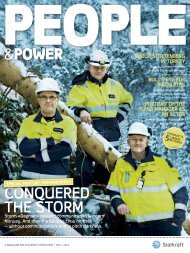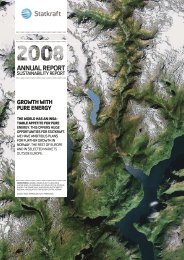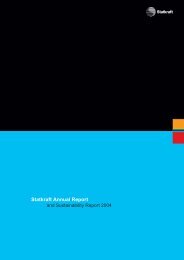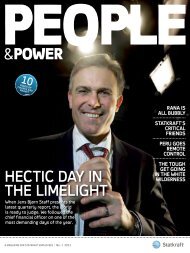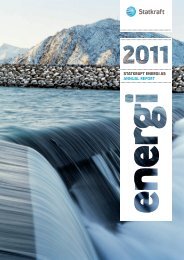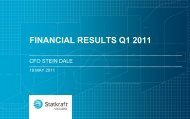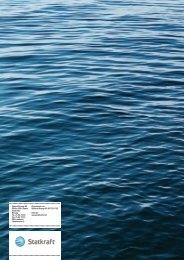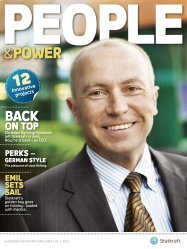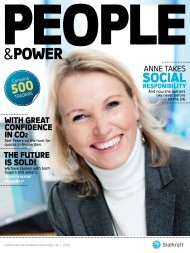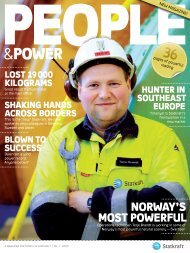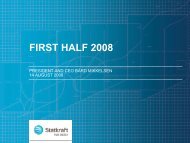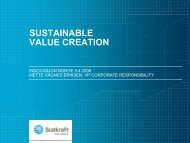Create successful ePaper yourself
Turn your PDF publications into a flip-book with our unique Google optimized e-Paper software.
Fe<strong>AT</strong>Ure<br />
26 StatKraft<br />
This is hard work, but it is mainly great fun. we’re doing<br />
something that has never been done before.<br />
Leon notKeviCh, eLeCtriCaL engineer.<br />
She points out that Forewind’s aim isnot to<br />
develop atany price.<br />
“We have nodesire tocarry out something<br />
with major environmental impact ,”she says.<br />
“That would goagainst everything we stand for.<br />
She adds that so far, none of the studies indicate<br />
that adevelopment should not take place.<br />
learning by Doing The <strong>Statkraft</strong> gang in<br />
Forewind have great confidence that the project<br />
is viable, but have no doubts that getting there<br />
will be demanding.<br />
”I’d say that we are ontrack now, but the<br />
schedule isvery tight,” says Leon Notkevich,<br />
one ofthree Norwegian <strong>Statkraft</strong> people in<br />
Forewind. “The Crown Estate has stated that<br />
everything must be in operation by 2020. So<br />
this is hard work, but it is mainly great fun.<br />
We’re doing something that has never been<br />
done before, and wehave every opportunity<br />
to be successful.”<br />
Although there are many possibilities, there<br />
are challenges aswell. One isthat the current<br />
cost level isfar too high, and another that<br />
the supply chain is too small to handle the<br />
development scale planned in Europe.<br />
“The entire supply chain must be upgraded,<br />
but nothing comes byitself,” says Tor Inge<br />
Vetvatne, economist. “In many ways, this is a<br />
chicken and the egg situation.”<br />
“They don’t want to build the plants before<br />
we place orders. And wedon’t want to place<br />
orders before they build the plants.”<br />
Adds Lugsdin: “And wedon’t want to order<br />
without alicense.”<br />
Forewind is not alone in the market.<br />
“The other companies in the third licensing<br />
round have the same needs as we do,” says<br />
Notkevich. “And wewill require all the cables,<br />
all the platforms, all the equipment available<br />
in the current market. Sothere isamad dash<br />
for the facilities.”<br />
“This issomething we need to take into account.<br />
And wehave todesign aproject that is<br />
flexible enough to handle various scenarios.”<br />
This is anew and rapidly growing industry<br />
where no one has any extensive experience,<br />
and all solutions are created onthe fly.<br />
“This industry has a low average age, and learning<br />
by doing is the order of the day. We learn<br />
something new every day,” says Barrell, who is<br />
25 years old and the youngest on the team.<br />
Wanting more to Do Although Sheringham<br />
Shoal and Dogger Bank provide more than<br />
enough to do for the team members, there is no<br />
indication that slower times are ahead. Olav Hetland,<br />
director of offshore wind, wants to acquire<br />
another project so that <strong>Statkraft</strong> can gain more<br />
experience in the period between the two others.<br />
At present, he is tight-lipped as to which projects<br />
he and his team are looking at to strengthen the<br />
expertise, but he emphasises that it is necessary<br />
to build on the experiences made from the offshore<br />
wind farm that will be completed next year.<br />
“Our strategyistoplayalong-termindustrial<br />
role,withstronginternalexpertiseinall project<br />
stages,”saysHetland. “Thisiswhat it will take for<br />
us to take on aleadingrole at Dogger Bank.”<br />
It mayseembig,but Sheringham<br />
Shoal is just thestart…<br />
Tomorrow’s technology<br />
<strong>Statkraft</strong>’semployees need<br />
to learnmanynew things<br />
…And have newconditions<br />
to work under<br />
Size is thebiggest<br />
difference betweenthe<br />
current turbines andthose<br />
of thefuture.<br />
OFFSHOre wIND eNerGy<br />
The turbines used on the Dogger Bank will be bigger<br />
than the current standard. Monitoring technology<br />
and research and development (R&D) are important<br />
aspects of Forewind’s work.<br />
“The most commonly-used turbines today have a capacity of<br />
3.6 MW,” says Patrice Aguilera, head of technology development<br />
in Forewind. “For Dogger Bank, we plan to use turbines<br />
that are significantly larger, with a capacity of between five<br />
and seven MW.”<br />
TwicEThE OslO PlAzA<br />
Some of theturbines will have 80 metre long rotor wings and<br />
be up to 230 meters high. In comparison, the tallest hotel in<br />
Northern Europe, the Oslo Plaza, is 117 metres tall.<br />
It has not yet been decided what sort of foundations will be<br />
used on Dogger Bank.<br />
“Monopillars are widely used today, but it could be that we<br />
need different solutions on Dogger Bank as monopillars have<br />
limitations in terms of depth and turbineweight,” says Aguilera.<br />
Size is the key difference between the current turbines and<br />
those used tomorrow, but the concept itself is changing, from<br />
so-called high-speed turbines to direct drive, where the latter<br />
is without a gear box. According to the suppliers, the advantages<br />
are that costs are reduced while reliability increases.<br />
EnOuGh PrOfiT?<br />
Cost efficiency is a keyword for <strong>Statkraft</strong>’s R&D efforts within<br />
the field.<br />
“We have a major and cost-oriented R&D activity targeting<br />
offshore wind energy. Lower costs is the be-all, and end-all<br />
in this industry, which currently depends on subsidies,” says<br />
Jørgen Krokstad who heads <strong>Statkraft</strong>’s R&D programme for<br />
profitable wind energy.<br />
“With a commitment of NOK 80 million over four years, R&D<br />
will contribute to clarifying whether the profit from offshore<br />
wind will be satisfactory,” says Krokstad. “Then we have issues<br />
such as wind resources and designing the farms, operations<br />
and maintenance, technology development and logistics.”<br />
DEmAnDinG insTAll<strong>AT</strong>iOn<br />
Oneofthe issues is that the size of the future turbines, in<br />
combination with Dogger Bank’s location far out to sea, poses<br />
certain challenges in relation to transport and installation.<br />
“We will require new vessels, and the installation will be very<br />
demanding,” says Aguilera. “The rotor blades are designed to<br />
catch the wind, and the average wind speed at Dogger Bank<br />
is 10.2 m/s. This is good when we are producing, but makes<br />
installation difficult.”<br />
Another challenge is to acquire machinery that has been<br />
tested properly.<br />
“We want machinery with a track record, meaning that they<br />
have been in operation for a few years,” she says. “We don’t<br />
want to have a test farm out there. In order to ensure that new<br />
technology actually works, we use a technology qualifying<br />
system called “Technology Readiness Level,” which is used by<br />
the petroleum industry in qualifying technology.”<br />
PEoPlE & PowEr<br />
27



